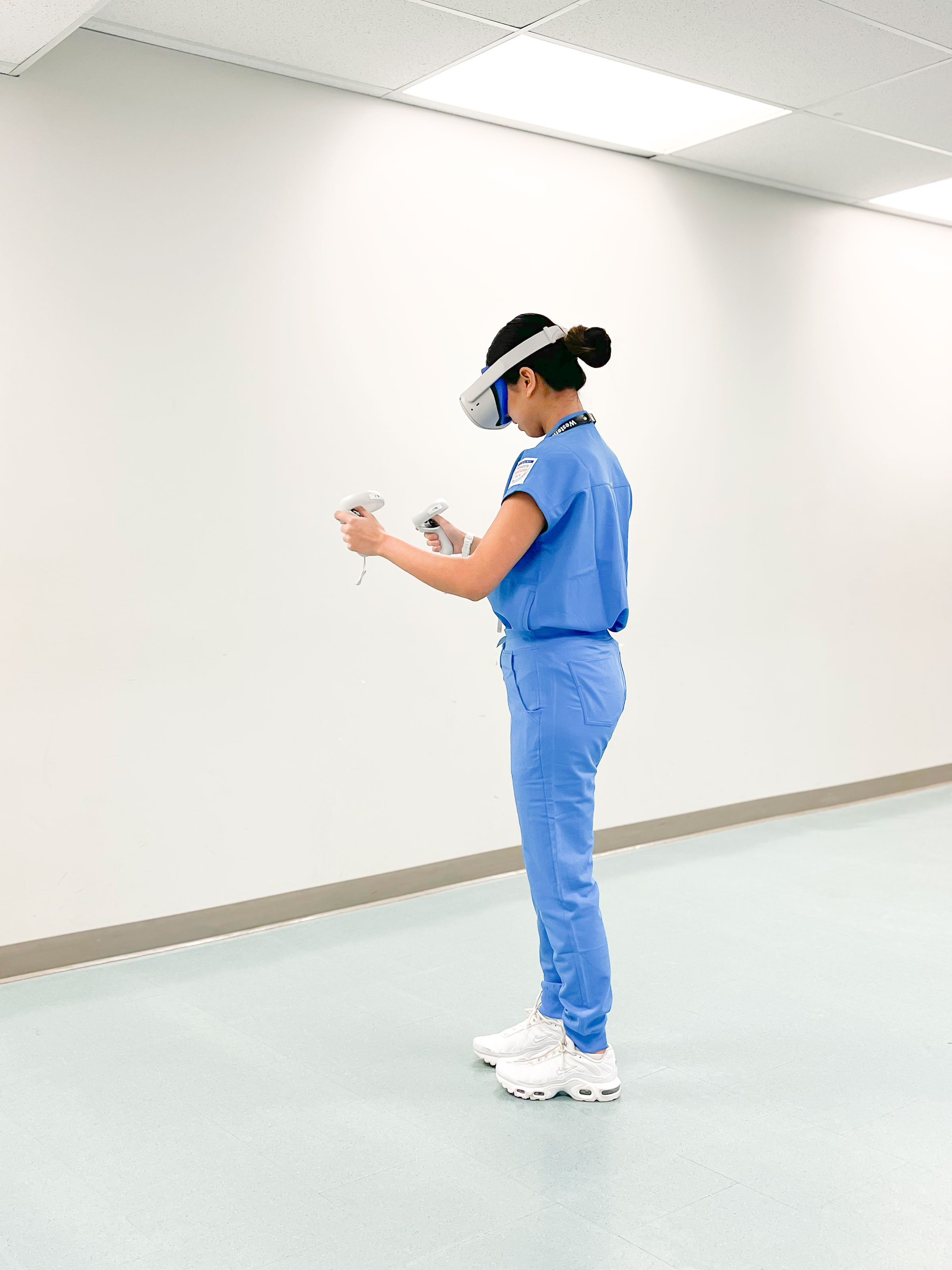
Table of Contents
Name of the heading
1- Start your table with the syntax {start-table}
2 - Add an H3 Heading to create a new column (this will be the column title)
3 - List cells as bullet points in a List element
4 - End your table with the syntax {end-table}
High Acuity Low Occurrence (HALO) Training with VR Simulation
Envision a tense moment in the sky: a malfunction has occurred mid-flight, forcing the pilot into an emergency landing. Despite never having flown a plane with one wing damaged in real-life, the pilot is well-prepared. They have been drilled on these High Acuity, Low Occurrence (HALO) events through high-fidelity simulation training, priming them for this exact scenario.
Similarly, in the ever-unpredictable world of nursing, professionals must also be ready to face their own HALO events. These rare but critical situations push the boundaries of a nurse's skills and knowledge, with lives frequently resting on their response. However, the question remains: how can we prepare nursing students for these abrupt, high-stakes scenarios?
Enter immersive virtual reality, an innovative approach to training that bridges the gap between theory and practice. Just as the pilot navigates the troubled plane to safety through training experience, immersive virtual reality equips nursing students to handle real-life medical emergencies efficiently and confidently.
UbiSim is an immersive VR platform built just for nurse learners, and we have many HALO events that can be simulated for nurse learners.
We’re going to delve into the transformative role of immersive VR in nursing education, especially in preparing students for HALO events.
Benefits of Immersive VR for HALO Events
1. Simulates Specific Experiences
Virtual Reality (VR) can be programmed to simulate a wide array of specific clinical situations that nurses might encounter in their practice, including High Acuity, Low Occurrence (HALO) events. This level of specificity allows nursing students to gain first-hand experience in managing these rare but critical situations, improving their decision-making skills, clinical judgment, and overall competence. They can get a feel for what these situations will be like, without having to wait for the rare chance to encounter one in real-life clinical practice.
For example, UbiSim has several HALO events:
- Anaphylaxis
- Myocardial infarction
- Diabetic ketoacidosis (DKA)
- Opioid toxicity
- Transfusion reaction
2. Risk-free Environment
One of the critical advantages of VR is that it offers a safe environment for learning and practicing. When dealing with HALO events, mistakes can have serious, potentially life-threatening consequences. VR allows nurse learners to practice these complex scenarios in a risk-free setting where they can make mistakes, learn from them, and improve their performance without any real-world consequences. This provides them the opportunity to build confidence in their abilities before they have to apply these skills in real life.
3. Realistic Simulations
VR technology has advanced to the point where it can create highly realistic, immersive simulations. Nurses can practice skills and procedures in a context that closely mirrors the real-world clinical setting. This means that they can develop a practical, hands-on understanding of what to do during HALO events rather than just a theoretical understanding. This level of realism also helps to prepare them emotionally for the pressure and intensity of these situations.
Hear from a Simulation Coordinator about the realistic nature of UbiSim: “I love the tiny details. You can get the alcohol pad and scrub the hub. There’s a trash can. Those sorts of things make it realistic. You can actually stick the patient, grab the tubes, and they fill up. It’s the details.” Lauren Ratcliff, Lamar State College
4. Repetition and Consistency
With VR, nurses can practice the same scenario as many times as they need to until they feel comfortable and competent. This allows for consistent and deliberate practice, which is known to be one of the most effective ways to learn and improve skills. Furthermore, every student can go through the exact same scenarios, ensuring a standard level of training and competency among all learners.
5. Cost-Effectiveness
Over the long term, VR can be more cost-effective than traditional methods of nurse training. While there are upfront costs, VR systems can be reused indefinitely and can train multiple individuals at once. Plus, they can simulate expensive, complex scenarios that might be too costly or logistically challenging to reproduce in real life.
Want to try simulating HALO events in immersive virtual reality using UbiSim for nurse education? Schedule a demo today.
FAQs
Heading 1
Heading 2
Heading 3
Heading 4
Heading 5
Heading 6
Lorem ipsum dolor sit amet, consectetur adipiscing elit, sed do eiusmod tempor incididunt ut labore et dolore magna aliqua. Ut enim ad minim veniam, quis nostrud exercitation ullamco laboris nisi ut aliquip ex ea commodo consequat. Duis aute irure dolor in reprehenderit in voluptate velit esse cillum dolore eu fugiat nulla pariatur.
Block quote
Ordered list
- Item 1
- Item 2
- Item 3
Unordered list
- Item A
- Item B
- Item C
Bold text
Emphasis
Superscript
Subscript
Explore more
.jpg)
Behind the Scenes: How We Brought Incisions & Dressings to Life in VR
How the UbiSim team built a VR system displaying 300+ distinct incision states—balancing clinical accuracy, technical constraints, and nursing education needs.
.jpg)
Step Inside the Room of Errors: Playful Exploration, Serious Skills
Learn how UbiSim's Room of Errors transforms nurse training through investigative play. Students spot hidden safety risks and build situational awareness.
.jpg)
1.19: Realism Learners Can Feel, Actionable Insights Educators Can Trust
UbiSim version 1.19 brings AI-powered narrative analysis, two new clinical scenarios, and enhanced wound care fidelity to nursing simulation.




